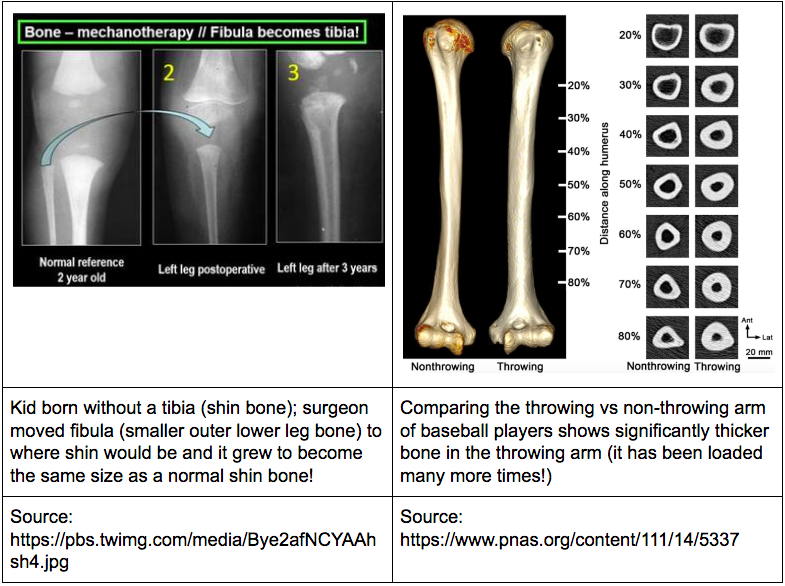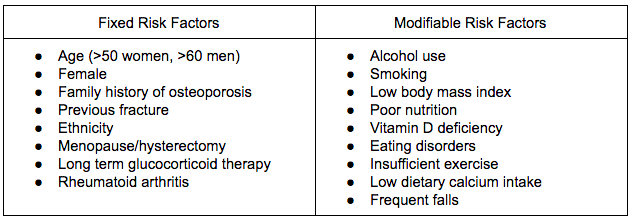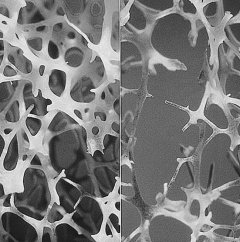
Osteoporosis is a skeletal disease that affects the whole body. It is characterized primarily by a decreased bone mineral density/mass which can lead people to be wary of exercising with this disease. Exercising with osteoporosis IS possible!
A primary concern with osteoporosis is that people with weakened bones are at an increased risk of experiencing bone fractures – coined “fragility fractures”.
In fact, most people with osteoporosis may not even know they have it because the disease is often asymptomatic until a fragility fracture occurs (Sanchez-Riera et al. 2010).
Osteoporosis is a common condition that affects over 200 million people worldwide, and it is most common in post-menopausal women (Reginster and Burlet, 2006).
This blog will clarify a little more about osteoporosis, the steps you should take if you’re diagnosed with it, and how physiotherapy can help!
Defining Osteoporosis
We’ve learned in previous blog posts that the tissues of the human body heal (grow) based on how they’re loaded. This is called Wolff’s Law. It’s how our bodies prepare for the things they are typically faced with.
Think of it as biological learning, much the way you learn the alphabet. To learn the alphabet, you start young, repeat it over and over again, even match it to a tune until your brain can recite it without really thinking. The alphabet becomes ingrained into your brain through repetition.
Other tissues in the human body can do the same thing. If you take a bone (for example your shin bone), and expose it to a load (for example, walking) over and over again, the shin bone gets bigger and stronger. The body believes it needs to be able to withstand a lot of load because it’s always being walked on. So, your body, by default, makes the bone stronger.
It does this through a constantly active mechanism of bone breakdown (resorption) and building (formation).
Here’s a couple really cool examples:

Human bones reach their maximum strength and density in our early 20’s. Then, unfortunately, over time, bone breakdown outpaces bone building.
In a healthy individual, bone breakdown is only slowly winning, so we can do things to combat it (more on that later). For individuals with osteoporosis, bone breakdown is outpacing bone building at a faster rate, and bones become progressively more brittle (don’t worry, you can still fight back!).
This may lead to a fragility fracture – the primary clinical concern associated with osteoporosis.
Fragility fractures are defined as bone fractures that occur with a fall from standing height or less. Most commonly, fragility fractures involve the hip, wrist, or spine (Sanchez-Riera et al, 2010).
Individuals with osteoporosis have been shown to have a lifetime fracture risk as high as 40% (Sanchez-Riera et al, 2010).
Determining whether or not someone has osteoporosis involves a medical test called a Bone Mineral Density (BMD) Test. This is usually done through a DXA (dual-energy X-ray absorptiometry) scan.
Most commonly, a DXA scan will measure bone mineral density in the hip and spine to assess the risk of osteoporosis. Results of a DXA scan are reported as a “T-score”.
The T-score is a reference measure in which the measured bone mineral density is compared to the bone mineral density of a healthy young adult.
The following table outlines what the T-score means, according to the World Health Organization:

Here’s an example of how bone looks at the cellular level. The left is normal, the right shows osteoporosis:
As mentioned, there are often no immediate signs of osteoporosis until a fracture occurs, so doctors will often try to determine one’s risk based on risk factors (see below for the list from the International Osteoporosis Foundation). Routine check ups with your doctor can also help you keep an eye on your bone mineral density, allowing you to intervene early if necessary.

You can’t really change your fixed risk factors, so focus is often on the modifiable risk factors. It is important to work with healthcare professionals to manage the modifiable risk factors most applicable to you.
If you have osteoporosis, your doctor will likely refer you to a rheumatologist – as they specialize in osteoporosis (among many other diseases). It is important to maintain consistent contact with your rheumatologist as they can provide you with the best medical advice to help manage your condition. This may include medication, supplementation (i.e. calcium and vitamin D), and will likely include an encouragement to remain active. This is where physiotherapists come in!
The Importance of Exercise & Exercising with Osteoporosis
As previously learned, insufficient exercise, frequent falls, and low body mass index can all be risk factors for osteoporosis. They’re also things that can be improved with exercise! Yes, that’s right, exercise can actually help you gain weight (muscle weighs more than fat!), if you’re doing the right things.
Exercise, specifically weight-bearing exercise, has been shown to improve:
- Muscle strength
- Muscle tone
- Balance
- Bone strength
Therefore, exercise helps to prevent/lessen:
- Falls
- Fractures
- Bone loss (remember, bones grow if they’re loaded!)
- Osteoporosis!
Furthermore, if you do happen to sustain a fragility fracture, exercise will be a big component of your rehabilitation!
Safe Exercise Examples
The primary focus for individuals with osteoporosis should be weight bearing exercise. Weight bearing exercises include, but are not limited to walkling, running, or jumping. Whereas cycling and swimming are non-weight bearing exercises.
This is where a physiotherapist comes in. A physiotherapist can work with you to help determine the most appropriate, and safe exercises tailored specifically to you. Of course, not every individual will be encouraged to perform high-impact jumping exercises!
The following exercises are excellent examples of weight bearing exercises that are safe for most individuals. That being said, they are not strict medical advice, and it is highly recommended you consult a physiotherapist if you have any questions, you are at a risk for falling, or you do not feel safe. Furthermore, this is certainly not an exclusive list of exercises, but it’s an excellent way to get started!
Exercise #1: Walking
That’s right! It’s that easy! Just walk. Walking is weight bearing exercise, and can therefore help reduce a decline in bone mineral density. I recommend starting with 10-20 minutes of walking, 3 days per week and progressing based on your fitness/comfort level. Progressing to a daily (or 5x/week) 30-60 minute walk would be an excellent goal!
Walking can also progress to include falls prevention drills. Walk on a pretend tightrope, walk sideways, walk backwards, walk on your tippy toes, or walk through an obstacle course. This way, you’ll improve your balance while also strengthening your bones! (Remember: safety first!)
Exercise #2: Squats
Aim for 3 sets of 10 repetitions. 3 days per week.
Beginner squat: Sit to stands
Setup: Begin sitting upright in a chair.
Movement: Cross your arms on your chest and lean your torso forward, then press into your feet to stand up. Slowly sit back down and repeat.
Tip: Make sure to maintain your balance and try to keep your weight evenly distributed between both legs. Do not lock your knees when you are standing.
Intermediate squat: Body weight squats
Setup: Begin standing upright with your feet slightly wider than shoulder width apart.
Movement: Bending at your knees and hips, squat down until your knees are close to a 90 degree angle, then straighten your legs and repeat.
Tip: Make sure to keep your back straight and do not let your knees bend forward past your toes.
Advanced squat: Weighted squats
Setup: Begin in a standing upright position, with your feet slightly wider than shoulder width apart, holding a weight in both hands in front of your chest.
Movement: Bending your hips and knees, slowly lower into a squat position, until your knees are close to a 90-degree angle, then straighten your legs and repeat.
Tip: Make sure to keep your back straight. Do not let your knees bend forward past your toes or collapse inward.
Exercise #3: Step ups
Aim for 3 sets of 10 repetitions. 3 days per week.
Beginner step up: Marching
Setup: Begin in a standing upright position with your feet shoulder width apart and hands resting on your hips.
Movement: Lift one leg with your knee bent, then lower it back to the ground and repeat with your other leg. Continue this movement, alternating between each leg.
Tip: Make sure to keep your back straight and do not let it arch as you lift your legs.
Intermediate step up: 1 stair step ups
Setup: Begin standing with your stairs in front of you.
Movement: Step up onto the first stair with one foot then follow with your other foot. Return back down to the starting position and repeat.
Tip: Make sure to maintain good posture during the exercise and do not let your knee bend forward past your toe as you step up.
Advanced step up: 2 stair step ups
Setup: Begin standing with your stairs in front of you.
Movement: Step up onto the second stair with one foot then follow with your other foot. Return back down to the starting position and repeat.
Tip: Make sure to maintain good posture during the exercise and do not let your knee bend forward past your toe as you step up.
Exercise #4: Push ups
This is for upper body weight bearing! Remember, the wrist is a common place to sustain a fragility fracture! Aim for 3 sets of 10 repetitions. 3 days per week.
Beginner push up: Wall push ups
Setup: Begin in a standing upright position with your arms straight and your hands resting on a wall at shoulder height.
Movement: Bend your elbows, leaning your body toward the wall, then push yourself back into the starting position and repeat.
Tip: Make sure to bend only at the elbows and keep the rest of your body straight during the exercise
Intermediate push up: Stair push ups
Setup: Begin in a standing position next to your stair, then lean onto straightened arms for support on the 5th stair.
Movement: Bend your elbows, slowly lowering yourself into a push up position, then push your body back up away from the stairs and repeat.
Tip: Make sure to keep your back straight and do not let your hips sag as you perform the exercise.
Advanced push up: Standard push ups
Setup: Begin on all fours on a comfortable surface. Move your body forward into a push-up position, with your arms slightly wider than shoulder width apart, knees straight, and feet together.
Movement: Slowly lower your body to the ground then push yourself back up and repeat.
Tip: Keep your back straight and maintain a gentle chin tuck throughout the exercise.
Conclusion
If you have osteoporosis, osteopenia, or would like to prevent it, reach out to a physiotherapist. A physiotherapist can assess your individual situation and teach you the safest exercises for you.
At Strive Physiotherapy & Performance, we are committed to providing an in-depth assessment to ensure we can work together to find the best plan of action for each individual client.
Call us at 519-895-2020, or use our online booking tool on www.strivept.ca to book an appointment with one of our knowledgeable physiotherapists, and they will be sure to help you understand your injury.
Take good care,
Tyler Allen
Physiotherapist at Strive Physiotherapy & Performance
References:
- Sanchez-Riera L, Wilson N, Kamalaraj N, Nolla JM, Kok C, Li Y, Macara M, Norman R, Chen JS, Smith EUR, Sambrook PN, Hernandez CS, Woolf A, March L 2010 Osteoporosis and fragility fractures. Best Practice & Research Clinical Rheumatology 24: 793-810.
- Reginster J, Burlet N 2006 Osteoporosis: A still increasing prevalence. Bone 38: 4-9.
